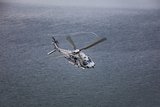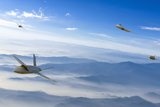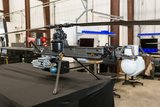UK Royal Navy Wildcat fires Sea Venom anti-ship missile
The Sea Venom missile can also be used for coastal suppression. (Photo: Crown Copyright)
A UK Royal Navy Wildcat HMA Mk2 attack helicopter has completed the first guided firing of an MBDA Sea Venom anti-ship missile, substantially increasing the capability of the aircraft.
The firing took place at the Aberporth range in Wales and was against a target vessel consisting of of three containers atop a barge. The target was designed and built by QinetiQ and each container wall had multiple individually controlled heating elements to simulate a target more accurately.
Lt Com Robin Kenchington, from the Royal Navy’s test and evaluation squadron 744 Naval Air Squadron, said: “Every aspect of the firing worked well.
“The Wildcat has another potent addition to its arsenal, increasing the ability of front-line crews to fight from a greater stand-off distance; this maximises their lethality whilst keeping them safe from enemy defences,” he added.
The Wildcat can already fire Sting Ray torpedoes for defeating underwater threats and lightweight Martlet missiles for attacking boat swarms or small ships but previously had been unable to act against larger warships such as corvettes.
Sea Venom is primarily anti-ship missile designed to destroy a range of attack craft up to large vessels from safe stand-off ranges at up to 20km away.
The missile has a 30kg warhead and coastal suppression capability, meaning it can hit shoreline targets, destroying potential threats to warships operating nearby. It can operate in a range of profiles, including sea skimming, and can be fired in a salvo.
Related Equipment in Defence Insight
More from Air Warfare
-
![The future is here: Sixth-gen air dominance]()
The future is here: Sixth-gen air dominance
How RTX is equipping the military airspace – for today’s fleet and tomorrow’s fight.
-
![Will fresh FCAS talks resolve political turmoil?]()
Will fresh FCAS talks resolve political turmoil?
German, French and Spanish leadership set an end-of-year deadline to decide the fate of the Future Combat Air System programme which has struggled with a political stalemate for the latter half of 2025.
-
![Anduril UK and GKN Aerospace collaborate on British Army ACP bid]()
Anduril UK and GKN Aerospace collaborate on British Army ACP bid
The pair will submit their demonstrator concept for Project Nyx, a development project for the British Army’s Land Autonomous Collaborative Platform.
-
![US Army command’s Picatinny CLIK common lethal drone interface makes progress]()
US Army command’s Picatinny CLIK common lethal drone interface makes progress
The Picatinny Common Lethality Integration Kit is designed to overcome the issue of unique integration methods between lethal payloads and drones as well as avoiding problematic acquisition conditions created by vendor lock.























